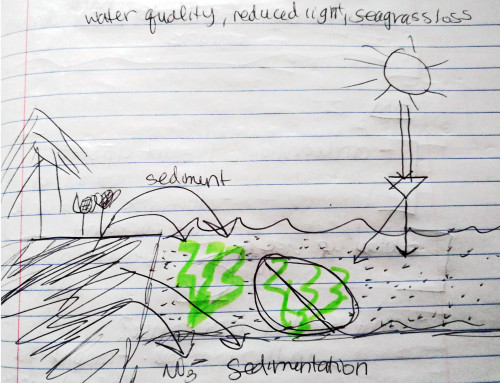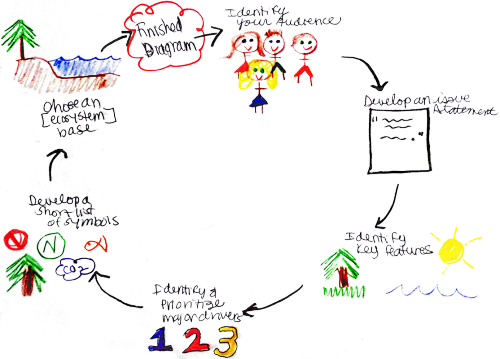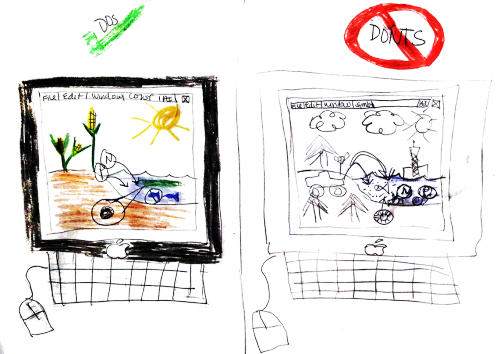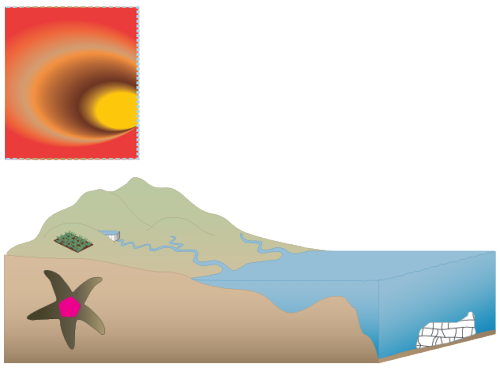A picture is worth a thousand words… but what about a conceptual diagram?
Christina Goethel ·Christina Goethel
Often times dissecting and reading a description of a scientific process can be time-consuming, tedious, and frustrating. As visual creatures, paragraphs and paragraphs of words on a page may elude us. To remedy this, we can turn scientific concepts and ideas into different forms of visualizations, diagrams, and pictures. One such visualization tool is the conceptual diagram, so what is that?
There is no better way to understand a new tool than to jump right in. So how does one jump right into designing conceptual diagrams? For our class it was to play a few quick rounds of “conceptionary”. Many of us have played the game Pictionary either with our friends or our family, but this game took a turn when science was added! Playing this game allowed us to take several declarative sentences describing a scientific phenomenon and turn them into a simpler, visually appealing diagram that didn’t lose any of the meaning.

With this quick, but productive game behind us, we reviewed our own conceptual diagrams each of us had hand drawn for class. This review resulted in a lot of productive discussion about the different components needed to create a conceptual diagram and some helpful dos and don’ts.

A conceptual diagram can come together with six steps [examples include my thought process for the creation of figure 3]:
- Identify your audience: In the case of figure three, my audience was the variety of people reading this blog post.
- Develop an issue statement - one sentence summarizing what you want to convey in your conceptual diagram: “When used and developed correctly, conceptual diagrams can be a powerful and effective tool in communicating science.”
- Prioritize key features: The majors dos and don’ts of a conceptual diagram
- Identify and prioritize major drivers.
- Develop a short list of symbols: mac apple symbol, computer, mouse, Illustrator interface, keyboard…
- Choose an [ecosystem] base: computer screen

Some of the major dos for a conceptual diagram:
- Use color to identify key features
- Make use of a blow up circle to show smaller details
- In circular diagrams, flow in a clockwise pattern
- Use easily recognizable symbols
- Draw largely so that details are clear
- Tackle one issue at a time, try and keep diagram uncluttered
- Use mirror images to display differences in a system
- Use arrows to denote a process, not to say “look here”
- Avoid cartoon-y details
Some things to avoid when creating a conceptual diagram:
- No use of color
- Lacking in blow ups to show detail
- Counterclockwise pattern, or presentation of future panels before past/present panels
- Small details that are not easy to see
- Putting too many processes into one diagram
- Use of too many arrows - often leads to a more cluttered diagram
We now had these hand drawings, which were powerful, but we could take it a step further by cleaning them up and computerizing them with Adobe Illustrator. After a quick tutorial, we were left with the tools to play around with Illustrator to bring our hand drawings to life.

After leaving today’s class, I began thinking about the power and the versatility of conceptual diagrams and several things struck me.
- The power of the conceptual diagram in its ability to bring a room full of people to an understanding about a phenomenon or idea. While playing “conceptionary” many of us drew very similar illustrations from the same simple sentence. I believe that this demonstrates the usefulness, strength, and universal qualities of imagery and symbolism.
- The second characteristic of the conceptual diagram that had me pausing to think was its versatility. Here we are a group of very different people, studying very different processes all using the same tool. We were able to produce illustrations of topics ranging from bat acoustics to the spread of the Zika virus and from coral bleaching to protein synthesis. While we are still learning and our diagrams are growing and changing, we are all still able to use this single tool to communicate our own individual science.
- My final thought on the conceptual diagram had me asking the question: If we flipped “conceptionary” around would it still show the power of the conceptual diagram. As I stated before, many of us drew similar images of the process described. While the style and artistic ability varied, the message of the diagram did not. Would doing the opposite produce the same effect, i.e. if one person drew a conceptual diagram would we all be able to produce similar, although stylistically different, declarative sentences describing what we saw in the diagram? I believe the answer to this question is yes. If indeed the answer to that question is yes, it experimentally demonstrates the power of the conceptual diagram. Because even if the style of the writing and select words are different, the underlying ideas would be the same, ultimately bringing a group of people, who likely have different backgrounds, together on an issue with one simple image.

For a concluding thought I would like to address the question I posed in the title. After seeing how a conceptual diagram can describe and illustrate such a diverse set of processes, I believe that it’s worth more than a 1000 words because it starts a discussion within and across communities, hopefully ultimately leading to solutions of the problems posed in this one dynamic tool….the conceptual diagram.
Next Post > Engaged participants made the Indian River Lagoon Report Card workshop a pleasure to facilitate!
Comments
-
MbS 10 years ago
Thank you C, for this excellent summary of our class work. Thank you also for the many illustrations and drawing you share.
I am very struck by this from the last part of your post:
The power of the conceptual diagram in its ability to bring a room full of people to an understanding about a phenomenon or idea.
To bring a room full of people toward understanding is utterly essential for rational and communal environmental policy making. In this way, conceptual diagrams not only teach but help create conditions for consensus and action. :)
-
Keota Silaphone & Dave Wilson 10 years ago
These are excellent comments. I would only add that one does not necessarily have to be a scientist to use the communication tools we're using in class. The symbols created through IAN will hopefully serve as a universal language among all users enabling the interpretation of conceptual diagrams to be more intuitive.
Estos comentarios son excelentes. Anadiria solamente que no es necesario ser un cientifico para usar instrumentos de comunicacion en la clase. Los simbolos creado por IAN pueden servir como un idioma universal con todos que se usan, habilitando la interpretacion de diagramas estar mas inuitivo.
-
Noelle O. 10 years ago
This blogpost was very well written! I love the incorporation of all the steps and stages you documented along the way and how you presented them.